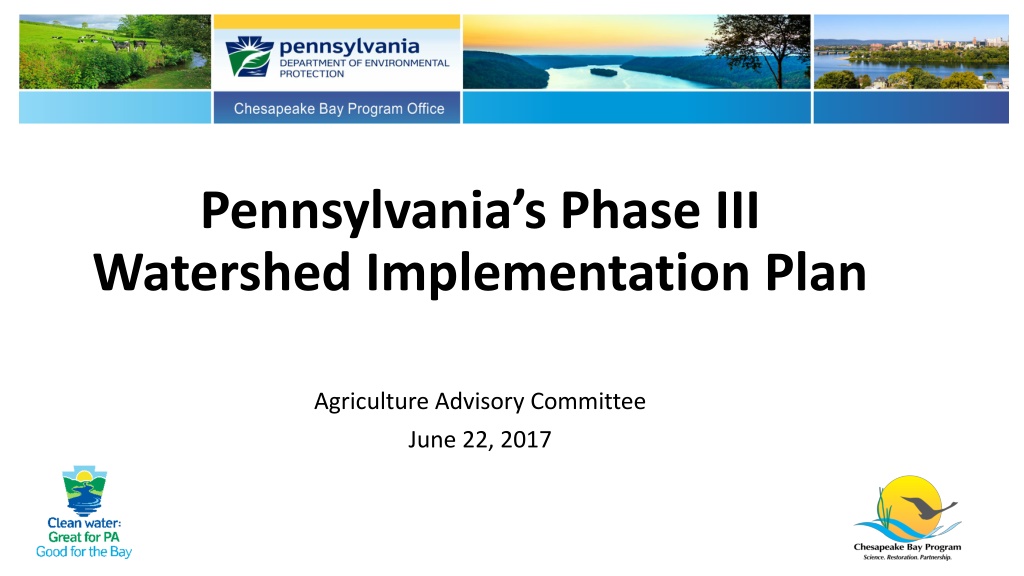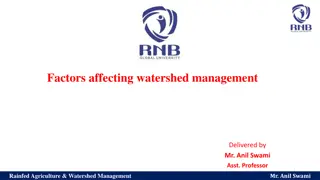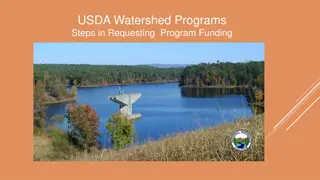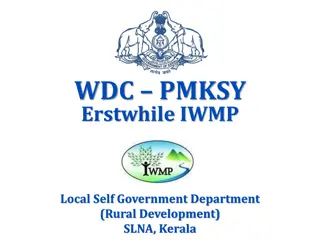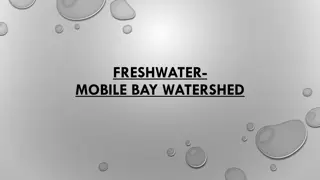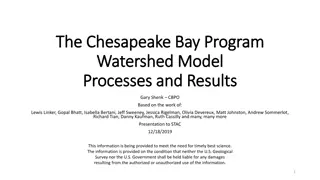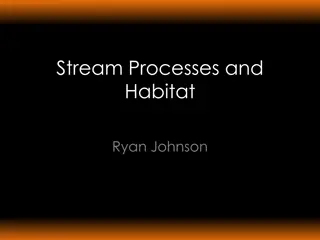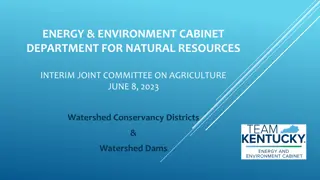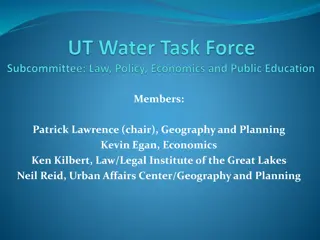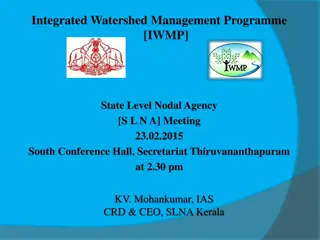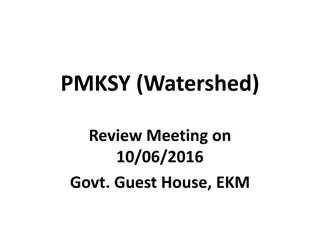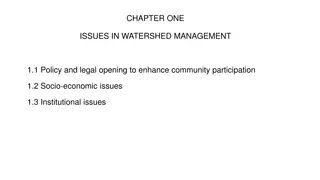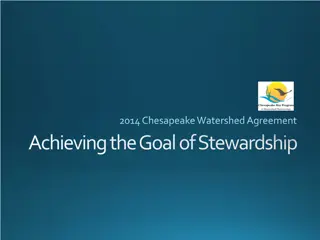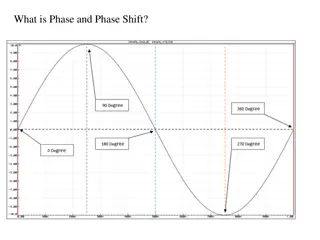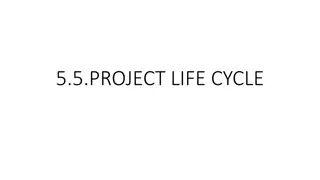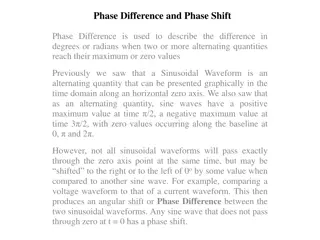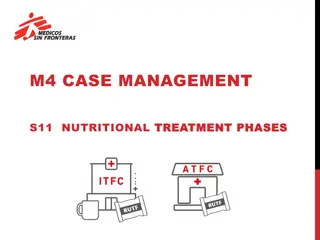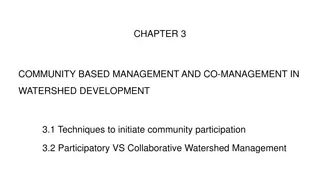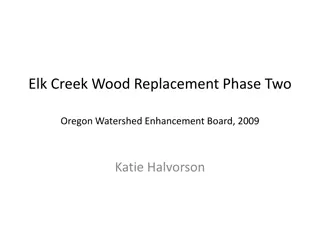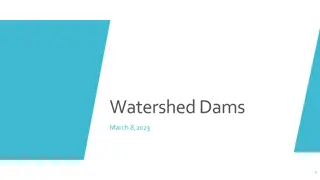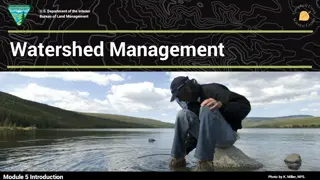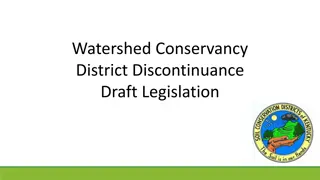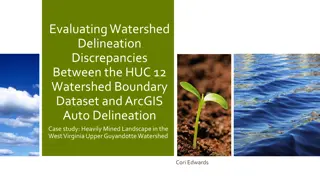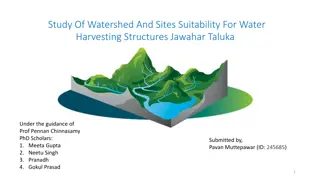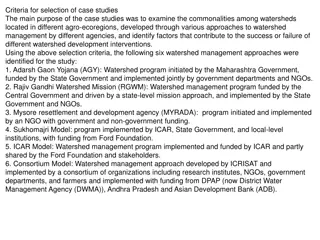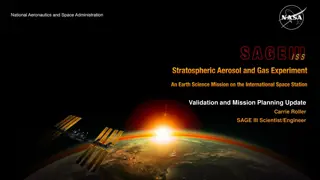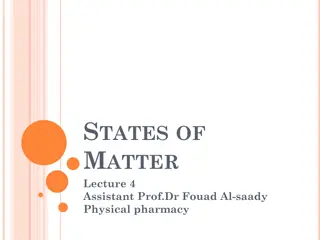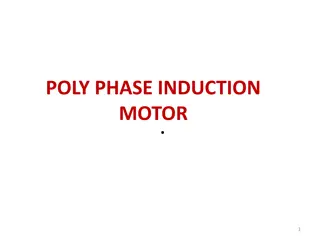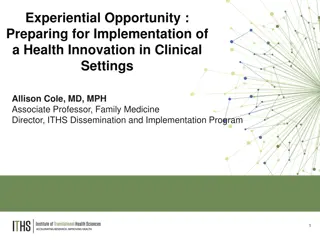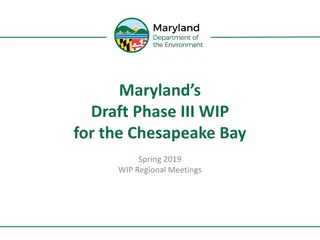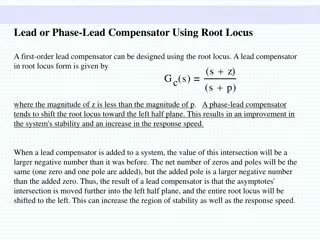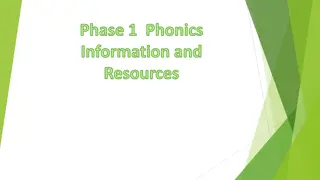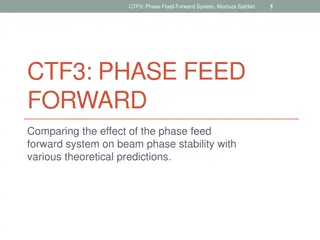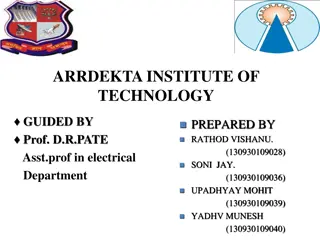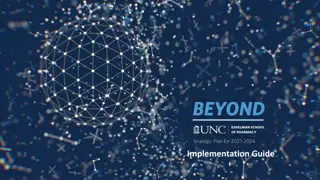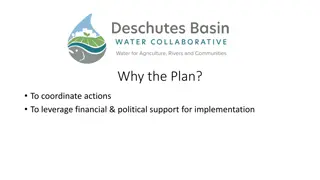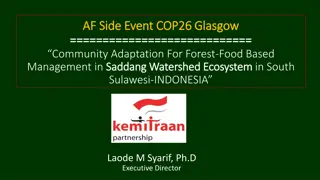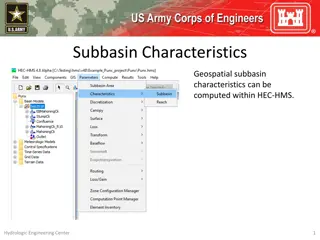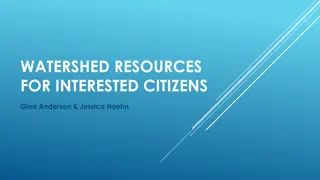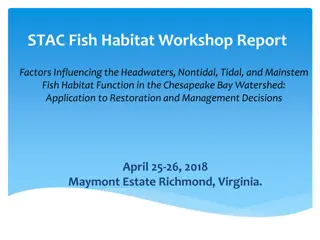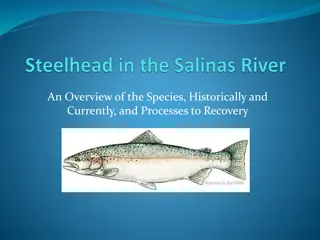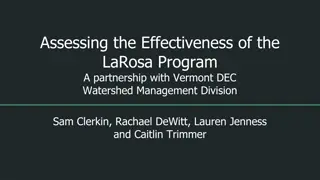Pennsylvania's Phase III Watershed Implementation Plan
Pennsylvania's Phase III Watershed Implementation Plan focuses on reducing nitrogen, phosphorus, and sediment loading to meet Chesapeake Bay Total Maximum Daily Load requirements by 2025. The plan involves various sectors like agriculture, urban runoff, and forest areas to achieve necessary reductions and restore water quality in the Bay watershed.
Download Presentation

Please find below an Image/Link to download the presentation.
The content on the website is provided AS IS for your information and personal use only. It may not be sold, licensed, or shared on other websites without obtaining consent from the author. Download presentation by click this link. If you encounter any issues during the download, it is possible that the publisher has removed the file from their server.
E N D
Presentation Transcript
Pennsylvanias Phase III Watershed Implementation Plan Agriculture Advisory Committee June 22, 2017
Agenda Why Are We Doing This? Progress Made and the Job Ahead of Us Need Your Engagement to Move Forward Midpoint Assessment Allocations Issues Schedule EPA Expectations Baywide PA Specific Phase 3 WIP Game Plan
Why Are We Doing This? Federal Clean Water Act, Federal court orders and regulations 2010 Chesapeake Bay Total Maximum Daily Load (TMDL) requires annual loading reductions of nitrogen, phosphorus and sediment Requires the return of Chesapeake Bay waters to Maryland state water quality standards by 2025 Pennsylvania s Clean Stream Law Article 1, Section 27, Pennsylvania Constitution The people have the right to clean air, pure water, and to the preservation of the natural, scenic, historic and esthetic values of the environment. As trustee of these resources, the Commonwealth shall conserve and maintain them for the benefit of all the people.
PAs Portion of the Bay Watershed PA encompasses 35.2% of the Bay watershed -- that s 14,358,159 acres. Four PA watersheds Susquehanna River (13,298,520 acres, 32.6%) Potomac River (1,012,222 acres, 2.5%) Eastern Shore (40,262 acres, 0.1%) Western Shore (7,155 acres, 0.02%)
What is a Sector? In the TMDL, pollutant sources were divided to efficiently reach facilities with similar operations, processes or practices Point Sources = Wastewater (Treatment Plants, Combined Sewer Overflows) Nonpoint Sources = Pollution from rainfall and stormwater runoff Agriculture farms or ranches that grow and harvest crops and animals for production Urban Runoff land area that has been developed, or is planned for development (ex. streets and parking lots) Forest areas covered in trees
Pennsylvania Nitrogen Loads: 2015 Pennsylvania Nitrogen Loads: 2015- -2025 Agriculture Urban Runoff 113 M lbs. (11 M lbs. reduced 1985-2015) 2025 Septic Wastewater+CSO Forest+ 79 M lbs. (34 M lbs. to reduce 2015-2025) 15% 1% 45% 28% Where Where will remaining Nitrogen remaining Nitrogen reductions* come from? reductions* come from? *Based on jurisdictions Phase II WIPs *Based on jurisdictions Phase II WIPs will the the 78% Agriculture 78% Agriculture 20% Urban 20% Urban 2% Septic 2% Septic 11% 2015 2025
Pennsylvania Phosphorus Loads: 2015 Pennsylvania Phosphorus Loads: 2015- -2025 2025 Agriculture Urban Runoff Wastewater+CSO Forest+ 4.3 M lbs. (1.7 M lbs. reduced 1985-2015) 3.6 M lbs. (0.7 M lbs. to reduce 2015-2025) 15% 1% 45% 28% Where Where will remaining Phosphorus remaining Phosphorus reductions* come from? reductions* come from? *Based on jurisdictions Phase II WIPs *Based on jurisdictions Phase II WIPs will the the 76% Agriculture 76% Agriculture 24% Urban 24% Urban 11% 2015 2025
Pennsylvania Sediment Loads: 2015 Pennsylvania Sediment Loads: 2015- -2025 2025 Agriculture Urban Runoff Wastewater+CSO Forest+ 2,500 M lbs. (540 M lbs. reduced 1985-2015) 1,900 M lbs. (513 M lbs. to reduce 2015-2025) 15% 1% 45% 28% Where Where will remaining Sediment remaining Sediment reductions* come from? reductions* come from? *Based on jurisdictions Phase II WIPs *Based on jurisdictions Phase II WIPs will the the 70% Agriculture 70% Agriculture 30% Urban 30% Urban 11% 2015 2025
Pennsylvanias Source Sector Challenges Needs to reduce 19 million lbs. nitrogen by 2017 and a total of 34 million lbs. by 2025 Responsible for 69 percent of remaining basinwide nitrogen load reductions by 2025 Agriculture will likely be responsible for more than 80 percent of these nitrogen reductions by 2025 How do we put the technical assistance/compliance infrastructure and cost share funding in place to deliver on these needed reductions
Total Nitrogen per Acre Loads and Trends: 2005-2014 Chesapeake Watershed Improving Trends: 54% Degrading Trends: 27% No Trend: 19% PA: Majority improving Improving: 14 Degrading: 3 No change: 1
Total Phosphorus per Acre Loads and Trends: 2005-2014 Loads per acre Above average in PA Eastern part of basin Bay Watershed trends: Improving Trends : 68% Degrading Trends : 20% No Trend : 12% PA trends: Majority improving Improving: 14 Degrading: 3 No change: 1
Total Suspended Sediment per Acre Loads and Trends: 2005-2014 Bay Watershed trends: Improving Trends : 47% Degrading Trends : 30% No Trend : 23% PA trends: Majority improving Improving: 9 Degrading: 3 No change: 6
Restoration Strategy: Six Elements 1) Address Pollutant Reduction 2) Quantify & Multiply BMPs 3) Improve Record-keeping 4) Identify Needed Changes 5) Establish a DEP Chesapeake Bay Office 6) Seek New Resources 14
Agricultural Inspection Initiative DEP began inspections August 29, 2016 Districts began inspections October 3, 2016 Preliminary Results (as of March 31, 2017): Over 1125 Inspections Completed Over 858 by Conservation Districts Over 264 by DEP Results of inspections to date Total Acres Covered 119,000 acres
50 50 38 50 25 50 50 50 38 50 38 50 50 63 50 50 88 50 25 50 50 50 300 100 75 75 50
Data Management Initiatives Penn State Farmer Self-Reporting Survey Results (6700 surveys returned!) 475,800 acres of nutrient/manure management; 97,562 acres of enhanced nutrient management; 2,164 animal-waste storage units; 2,106 barnyard runoff-control systems; 55,073 acres of agricultural erosion and sedimentation control plans; 228,264 acres of conservation plans; More than 1.3 million linear feet of stream-bank fencing; 1,757 acres of grass riparian buffers; and 5,808 acres of forested riparian buffers. Total estimated reductions: Nitrogen -- 1,047,704 lbs/year Phosphorus -- 79,620 lbs/year Sediment -- 10,395,906 lbs/year NRCS Potomac Watershed Remote Sensing Project Collected data on 26 conservation BMPs using a grid approach Field verification spot checks were done by experienced NRCS staff using the standard USDA NRCS 5% quality assurance/quality control sample
Data Management Initiatives Worldview Development Used the existing database design that was created for five Pennsylvania county conservation districts and Virginia Department of Environmental Quality Submitted 2016 Progress Data Using the new Database Software PracticeKeeper Software Launch to ALL Districts in July, 2017 6 Modules Nutrient Management, E & S Planning, Watershed Projects, Complaints and BMPs DEP staff and 9 Districts pilot testing starting now Hardware for PracticeKeeper Funding Distributed for tablets for in-the-field data collection
Urban Stormwater Cost Share Program Municipalities, MS4 Communities in Blair, Cumberland, Dauphin, Franklin, Lackawanna, Lancaster, Lebanon, Luzerne, Lycoming and York Counties $200,000 maximum per grantee Round #1 (Awarded July, 2016) Over $2.2 million awarded to 19 projects Round #2 (To be announced shortly) Over $5.5 million requested for 40 projects Expect to award around $2.3 million
Conservation District Special Projects Support Implementation of the Restoration Strategy BMP Implementation Projects in areas identified as part of the Agricultural Inspection Strategies In impaired watersheds or priority watersheds identified by the County in their Implementation Plans BMP verification and tracking, including the further documentation of voluntary practices Priority Projects: Comprehensive solutions, Plan Implementation, Regulatory Compliance More emphasis placed on shovel ready projects where designs are completed Available funding is $2.5 to $3 million (2 years funding) Over $4.4 million requested for 58 projects Projects MUST be completed by June 30, 2019.
EPA Baywide ExpectationsTop 4 Programmatic and numeric implementation commitments for 2018-2025 Strategies for engagement of local, regional and federal partners in implementation Account for changed conditions: climate change, Conowingo Dam infill, growth Develop, implement local planning goals below the state- major basin scales
EPA Pennsylvania Expectations EPA Pennsylvania Expectations Programmatic, policy, legislative and regulatory changes needed Demonstration of the staff, partnerships and financial resources needed A dedicated and targeted annual state cost-share program Next steps as we move forward: Evaluate the expectations and define how the Commonwealth can meet these expectations or Define a viable alternative to their expectations that achieves the same end result. EPA Actions Continue to target federal compliance and enforcement actions Direct or withhold federal funding Establish finer scale load allocations through a Pennsylvania-specific amendment to the TMDL Require additional reductions from point sources Promulgate nitrogen and phosphorus numeric water quality standards for Pennsylvania streams and rivers
Midpoint Assessment Data Collection & Analysis Water Quality Monitoring and Trend Analysis Conowingo Dam Climate Change Sector Growth Policy and Methodology Decisions Planning Targets By state, basin Equity vs Cost-effectiveness Model Calibration Expert Panel Reports BMP Efficiencies Historical Data Cleanup
Midpoint Assessment Schedule June-July: 2017: Partnership s review of models October 2017: Draft Phase III WIP planning targets Resolution of Issues around Conowingo, Climate Change, Sector Growth October - Feb 2018: Partnership review of targets Feb 2018: Final Phase III WIP planning targets Dec 2018: Draft Phase III WIPs shared for partner, stakeholder review Mar 2019: Final Phase III WIPs due
Phase 3 Watershed Implementation Plan Stakeholder Input and Outreach Steering Committee/Workgroups Website Communications Strategy Being Developed: One-Day Kick-Off Conference, Listening Sessions, Public Comment Planning Targets & Implementation Sector Specific Local Area Goals Priority Areas/Watersheds Measurable Outputs, Milestones Emphasis on Local Water Quality, Local Goals, Local Benefits
Local Planning Goals Jurisdictional Boundaries (County, Township, Borough, Conservation District) Federal or State Facilities Regional Entity Boundaries (River Basin Commission, Planning Commission) Watershed or sub-watershed Segment-shed as defined in the TMDL Area with a defined need for pollutant reduction (ex. MS4s) Targeted area with high pollutant loadings
Phase 3 WIP Schedule April, May, 2017 Form Steering Committee and Workgroups June 5, 2017 Phase 3 WIP Kick-Off Conference, Radisson Harrisburg June 3 July 7, 2017 Follow-up Written Comment Response to Conference July 2017 through October 2017 Bay Program Partnership Works Through Issues Workgroups Formed, Convened Comments Compiled, Additional Information and Data Compiled October 2017 through May 2018 Workgroups and Steering Committee develop the WIP Additional Outreach Around Development of Local Planning Goals/Sector Specific Plans August/September 2018 Public Comment Period of Draft Phase 3 WIP December 2018 Submit to EPA for Partnership Review January 2019 Revise in Response to Partnership Review March 2019 Submit Final Phase 3 WIP
Public Comment What key elements need to be included for this effort to be a success? What priority issues MUST be addressed in the Phase 3 WIP for me to agree the plan would be implementable? Is there a particular initiative, action, partnership, training that would aid this effort? When 2025 arrives, what measurable outcome does Pennsylvania need to achieve that would make you agree that this effort was a success? Are there possibilities for continuing and enhancing current projects or initiatives?
Other Resources Chesapeake Bay Program Website http://www.chesapeakebay.net Chesapeake Bay Assessment Scenario Tool - CAST http://www.casttool.org County level scenario calculator Chesapeake Bay Facility Assessment Scenario Tool - BayFAST http://www.bayfast.org Facility level scenario calculator Phase 6 Model Data Visualization Tool New Beta 4 Run https://mpa.chesapeakebay.net/Phase6DataVisualization.html
Contact Information: Veronica Kasi vbkasi@pa.gov 717-772-4053 DEP Chesapeake Bay Website: http://www.dep.pa.gov/ChesapeakeBay
